|
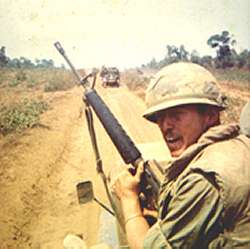 This
picture was taken four months into my tour. We are on convoy out to
Plie M'Rong. It has been dry for a while, and the red dust is like talcum
powder. We are headed out to take over the base for the guns of A Battery
that were headed into Cambodia during the invasion. We were just sure
we would go, because Charlie Battery was known as a "swing" battery.
Wherever there was trouble at least some guns of Charlie Battery would
answer. We were somewhat hurt that we weren't picked, but we were also
exhausted from making ten moves in the previous month. I suppose command
thought we needed a rest, and were got what passed for slack time for
at least two weeks, and then things started to heat up, and the section
had just five men, and the work got heavy again. We pulled out of Plie
M'Rong in late March, and headed for Dak To II, between Than Can and
Ben Het. A Special Forces camp at Dak Seang had come under siege, and
the ARVN were going to try to relieve it. It would be one of the most
frustrating times I would have in Viet Nam. This
picture was taken four months into my tour. We are on convoy out to
Plie M'Rong. It has been dry for a while, and the red dust is like talcum
powder. We are headed out to take over the base for the guns of A Battery
that were headed into Cambodia during the invasion. We were just sure
we would go, because Charlie Battery was known as a "swing" battery.
Wherever there was trouble at least some guns of Charlie Battery would
answer. We were somewhat hurt that we weren't picked, but we were also
exhausted from making ten moves in the previous month. I suppose command
thought we needed a rest, and were got what passed for slack time for
at least two weeks, and then things started to heat up, and the section
had just five men, and the work got heavy again. We pulled out of Plie
M'Rong in late March, and headed for Dak To II, between Than Can and
Ben Het. A Special Forces camp at Dak Seang had come under siege, and
the ARVN were going to try to relieve it. It would be one of the most
frustrating times I would have in Viet Nam.
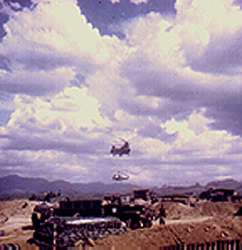 We
were put next to the airstrip at Dak To II. I had read about the big
battle at Dak To, and here we were three years later fighting over some
of the same ground that the 173rd Airborne Brigade, and 4th Infantry
had fought so hard to control. We received our first incoming only minutes
after pulling into our new home. A 122mm rocket came slamming into the
ground about fifty yards from our gun. That was the only incoming, and
later an arial observer said that it appeared that a rocket blew up
after leaving the tube, and killed the crew. He spotted two KIA, and
a launcher in a clearing along with some unfired rounds. They were not
done with us though, the rockets would fly, and I would be the gunner
in a couple of extented artillery duels. We
were put next to the airstrip at Dak To II. I had read about the big
battle at Dak To, and here we were three years later fighting over some
of the same ground that the 173rd Airborne Brigade, and 4th Infantry
had fought so hard to control. We received our first incoming only minutes
after pulling into our new home. A 122mm rocket came slamming into the
ground about fifty yards from our gun. That was the only incoming, and
later an arial observer said that it appeared that a rocket blew up
after leaving the tube, and killed the crew. He spotted two KIA, and
a launcher in a clearing along with some unfired rounds. They were not
done with us though, the rockets would fly, and I would be the gunner
in a couple of extented artillery duels.
This is a picture of a Chinook airlifting a wounded huey off of our
airstrip, and taking it back to Plieku. I believe the airlift of wounded
choppers was called Pipesmoke. I guess they had it down to a fine science
about how to strip all the hardware out of the bird, and sling it out
quickly. We would have several choppers come in that were hurt. They
were all quickly repaired, or hauled out. I had never seen choppers
smoking and sounding sick before like I did here. We had one huey come
in with all four men aboard hurt in some fashion. Either the pilot,
or Co-pilot died before the medivacs could get there. I don't know what
happened to the rest of the crew.
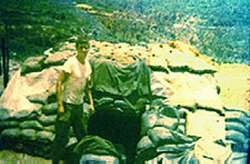 This
was home sweet home at Dak To II. By the time we left we had fourteen
layers of sandbags on this palace. We took a direct hit with a recoiless
rifle right in the back, and an hour after the shooting stopped, we
had five more layers back there. The man standing in front of the hooch
is named Johnson. He was from the 1st Infantry Division, and had seen
lots of action already. He wasn't too happy to be sent up north just
to pick up where he had left off with them. He made it though, and went
home about two months later. Behind the hooch about two hundred meters
is a little river called the Soui Ca I believe. Past that are some hills
that we called "Rocket Ridge" with good reason. It was off this ridge
that a lone 122mm rocket was launched that hit the ammo dump at Tan
Canh. The result was a rather long and large series of explosions. From
our base, we could see the shock waves, as whole pallettes of powder,
and ammo went off. Our cooks were in the camp near the ammo dump, and
though none of them were injured, I guess they spent a sleepless night
while the sky rained metal, and flame on them This
was home sweet home at Dak To II. By the time we left we had fourteen
layers of sandbags on this palace. We took a direct hit with a recoiless
rifle right in the back, and an hour after the shooting stopped, we
had five more layers back there. The man standing in front of the hooch
is named Johnson. He was from the 1st Infantry Division, and had seen
lots of action already. He wasn't too happy to be sent up north just
to pick up where he had left off with them. He made it though, and went
home about two months later. Behind the hooch about two hundred meters
is a little river called the Soui Ca I believe. Past that are some hills
that we called "Rocket Ridge" with good reason. It was off this ridge
that a lone 122mm rocket was launched that hit the ammo dump at Tan
Canh. The result was a rather long and large series of explosions. From
our base, we could see the shock waves, as whole pallettes of powder,
and ammo went off. Our cooks were in the camp near the ammo dump, and
though none of them were injured, I guess they spent a sleepless night
while the sky rained metal, and flame on them
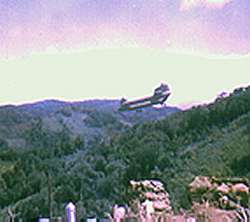 This
shot is of a chinook that had to drop its load of 155mm shells into
the jungle, at the bottom of a steep ravine. The wind was just howling
that day, and a down draft nearly downed the chopper. The infantry went
down with some engineers, and blew the shells in place. Three of us
went down with them to see if we could find a box of primers, and some
time fuses. We found the primers, but the fuzes were so bent up that
they threw them on the pile, and put about ten pounds of C-4 around
it, and blew it all up. We were back up the hill when they lit the pile
off, and it about knocked us down. I can imagine what it was like for
the men down the hill! The place we were at was called LZ Baxter, up
in the hills south of the Mang Yang. We were working with the Fourth
Infantry Division, and it sure was nice to have the resupply and support
systems that the American units could give you. It was also nice to
be able to have a conversation with your perimeter guards. In fact,
it was nice to have perimeter guards. This
shot is of a chinook that had to drop its load of 155mm shells into
the jungle, at the bottom of a steep ravine. The wind was just howling
that day, and a down draft nearly downed the chopper. The infantry went
down with some engineers, and blew the shells in place. Three of us
went down with them to see if we could find a box of primers, and some
time fuses. We found the primers, but the fuzes were so bent up that
they threw them on the pile, and put about ten pounds of C-4 around
it, and blew it all up. We were back up the hill when they lit the pile
off, and it about knocked us down. I can imagine what it was like for
the men down the hill! The place we were at was called LZ Baxter, up
in the hills south of the Mang Yang. We were working with the Fourth
Infantry Division, and it sure was nice to have the resupply and support
systems that the American units could give you. It was also nice to
be able to have a conversation with your perimeter guards. In fact,
it was nice to have perimeter guards.
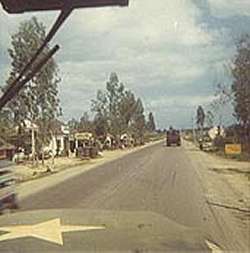 This
is a picture taken between Phu Cat, and Bong Song in February of 1970.
We had done ten march orders in January with the 4th Infantry, and now
I was just riding shotgun on this move. Two guns were going to be airlifted
from LZ English, while I would be riding back to my gun at Firebase
Blackhawk. All I would have to do is pucker through one more trip up
the Mang Yang Pass. Those who went through there know what I mean. The
coast was very different from the highlands. While it could get hot,
it seldom was as muggy as I found it out on the coast. I was almost
glad to get back in the hills. We saw Korean troops starting at the
An Khe Pass, and all along Hiway 1. I think they were from the White
Horse Division if memory serves, and it seldom does anymore. This
is a picture taken between Phu Cat, and Bong Song in February of 1970.
We had done ten march orders in January with the 4th Infantry, and now
I was just riding shotgun on this move. Two guns were going to be airlifted
from LZ English, while I would be riding back to my gun at Firebase
Blackhawk. All I would have to do is pucker through one more trip up
the Mang Yang Pass. Those who went through there know what I mean. The
coast was very different from the highlands. While it could get hot,
it seldom was as muggy as I found it out on the coast. I was almost
glad to get back in the hills. We saw Korean troops starting at the
An Khe Pass, and all along Hiway 1. I think they were from the White
Horse Division if memory serves, and it seldom does anymore.
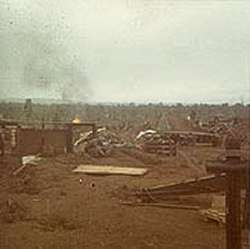 This
has to be the first day at Firebase Emilia. That pallet in the background
is our powder, and we would never leave it exposed, or stacked like
that for any length of time. I see that the spades are still dug in,
so there is an ongoing fire mission. The fire in the background is the
extra powder being burnt. Our gun had a maximum powder charge of 7.
This was five actual bags of powder weighing in at about 19 pounds.
It would spit our 100lb rounds about 9 miles. At a new firebase, you
liked to fire charge 7, and keep on firing max. charge throughout your
stay. If you started with charge six (one bag taken out) and then went
to charge four, you got very interested. If you then went to charge
three, you knew something was up. If you dropped from white bag to green
bag (very short range powder) you then became excited! What ever you
were shooting at was getting closer. At Dak To II we fired some high
angle green bag, and we could watch the round go up and behind a ridge
that was about 1/2 mile away, and hear the round go off. Pretty exciting
stuff! I always hated the firebases that started off with charge four,
and went down from there. Didn't they know we were supposed to be farther
away than that!? This
has to be the first day at Firebase Emilia. That pallet in the background
is our powder, and we would never leave it exposed, or stacked like
that for any length of time. I see that the spades are still dug in,
so there is an ongoing fire mission. The fire in the background is the
extra powder being burnt. Our gun had a maximum powder charge of 7.
This was five actual bags of powder weighing in at about 19 pounds.
It would spit our 100lb rounds about 9 miles. At a new firebase, you
liked to fire charge 7, and keep on firing max. charge throughout your
stay. If you started with charge six (one bag taken out) and then went
to charge four, you got very interested. If you then went to charge
three, you knew something was up. If you dropped from white bag to green
bag (very short range powder) you then became excited! What ever you
were shooting at was getting closer. At Dak To II we fired some high
angle green bag, and we could watch the round go up and behind a ridge
that was about 1/2 mile away, and hear the round go off. Pretty exciting
stuff! I always hated the firebases that started off with charge four,
and went down from there. Didn't they know we were supposed to be farther
away than that!?
|